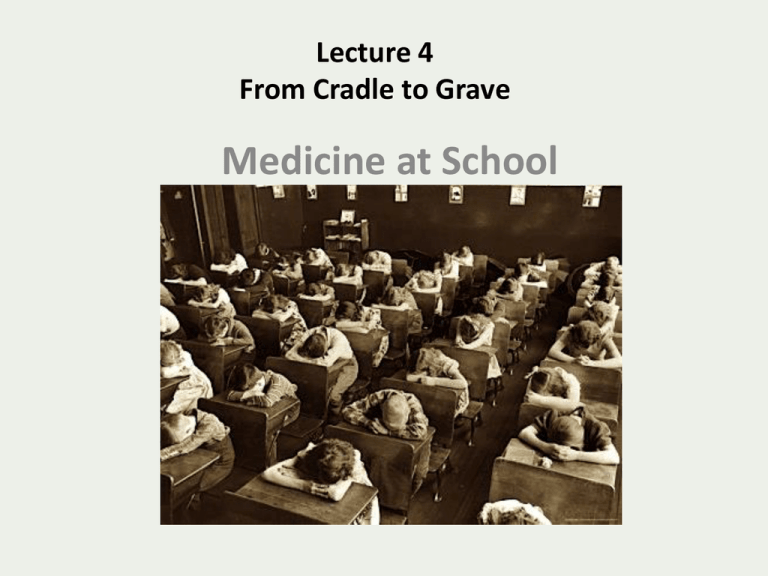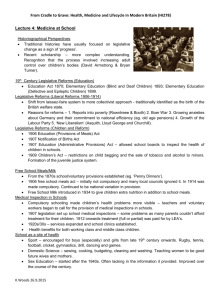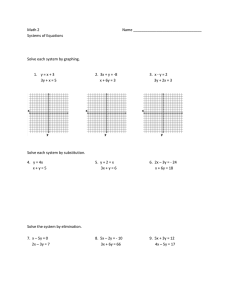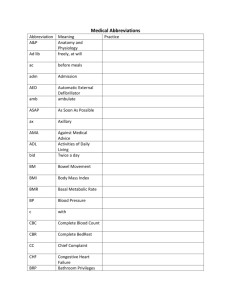Medicine at School Lecture 4 From Cradle to Grave
advertisement

Lecture 4 From Cradle to Grave Medicine at School Themes 1. State – parents – children: who is responsible for health? Who pays and who provides? 2. School as a new site of health interventions 3. Visibility of school children and their health problems Lecture Outline • Legislative Reforms • Education • Liberal Reforms • Children and Reform • Health provision through school • Free School Meals/Milk • Medical inspection • Schools as sites of health • Sport • Domestic science • Sex educaion Liberal Reforms • Key period: 1906-14 • Liberals win 1906 General Election • Shift in outlook from laissez-faire to more collectivist approach • Reforms often seen as the emergence of the ‘modern welfare state’ Reasons for Reforms • Concerns about poverty influenced by social inquires e.g. Charles Booth and Seebohm Rowntree • Concerns about physical (and mental) deterioration (Boer Wars). • Concerns about Germany and their commitment to national efficiency. • Threat of Labour Party and trade unions • Emergence of New Liberalism (e.g. David Lloyd George) Areas of reform • Birth – 1907 the Notification of Births Act • Children – 1906 free school meals for the necessitous – 1907 medical inspection in schools • Elderly – In 1908, Old Age Pensions for those over 70 – 5s a week to single men and women – 7s 6d to married couples, on a sliding scale • Workers – 1911 National Insurance Act (Part I) and (Part II) – 9s p/wk for 26 wks of sickness (Part I) – 7s6d p/wk for unemployment (Part II) Children and Reform • In 1906 Education (Provision of Meals) Act • 1906 Board of Education Report on Infant Education • 1907 Medical inspections of schoolchildren introduced • 1907, number of free scholarship places in secondary schools increased • 1907 Probation Act • 1908 Children and Young Person's Act and Children’s Charter Free school meals Free school meals • After 1870s schoolchildren more visible • From Mid-1870s local initiatives in some schools e.g. Mid1880s Penny Dinners provided Birmingham, Bristol and London • 1888 - 45,000 children at 48 school boards in London dependent on school meals. • 1906 Education (Provision of Meals) Act. Meals free for the necessitous only • Controversial. A voluntary system and many local councils ignored it. • 1914 made compulsory -14 million meals per school day were served (compared with 9 million per school day in 1910 Opposition to school meals provision ‘The individual and the family, as well as for their own good as for the common good, should provide themselves with the necessaries of maintenance, by their own exertions and out of their own resources. By such action [introduction of free school meals] the motive for a sound and well-ordered family life is weakened… By a law of social development… the individual and the family under normal conditions have to maintain themselves…’ B. Bosanquet, Lectures on Charitable and Social Work (1901) Elimination of malnutrition? • 1932 Board of Education - 1% of schoolchildren malnourished. • Chief Medical Officer claimed ‘the schoolchildren of this country are better nourished than at any previous time of which we have record’. • 1934 School milk scheme • Great regional variation • Social surveys - e.g. John Boyd Orr claimed high incidence of rickets, dental decay and anaemia in 1936, and suggested 20% of children malnourished. Provision of meals and milk 1938 - 268 LEAs provided free school meals 635,000 children receiving free milk 176,000 children receiving free meals Health of school children 1909 in Stockport MOH inspected 4,000 children 59% had ‘various defects’ 600 dirty heads 800 ‘mouth breathers’ 300 heart disease and anaemia 65 ringworm and skin diseases Medical inspection of school children • After 1870s children and their defects more ‘visible’. • 1896 committee Mental and Physical Condition of Children • Child Study Association/Childhood Society • 1890 London School Board appointed first school medical officer, Bradford 1893. • 1907 medical inspection of school children introduced • 1912 medical treatment provided, largely ignored by local authorities Opposition to School Medicine • Parents suspicious – a new method/technique • Hospitals didn’t want departments overrun with children and their families • GPs wanted to be the ones to treat – afraid of damage to professional interests and loss of income Impact of School Medical Service • Inspections by doctors and nurses increased • School clinics established as main form/site of care and treatment • System gradually expanded – by 1930s almost every LEA offered treatment for minor ailments such as dental defects and defective vision • New treatments introduced e.g. artificial light for treating rickets, lupus and non-pulmonary TB • Major deficiencies in service • Provision varied from locale to locale Light therapy Agreement is almost unanimous as to the tonic effect of ultra-violet radiation on debilitated children, [as] shown by their improved appetite, activity and nervous stability’. (George Newman, Board of Education, 1928) Local authorities providing medical treatment Year Provision Clinics Hospital Spectacles 1908 55 7 8 24 1914 266 179 75 165 1917 279 231 95 223 1920 309 288 168 282 Number of LEAs between 328 and 317 Table from J.David Hirst, ‘The Growth of Treatment Through the School Medical service, 1908-18, Medical History, 33 (1989), pp.318-342, p.330. Just poor children….? ‘E.B. Rheumatic. Heart weak. Gymnastics good for her, but she needs to be carefully watched’. ‘L.B. Slight and delicate. R. lung not quite sound. Gymnastics very useful but care to be taken’. ‘E.P. A nervous excitable child subject to headaches. Weak trunk muscles and chest habitually contracted... Must rest between all the exercises longer than the others and not go in when she has a headache or a period’. North London Collegiate School Archives (NLCSA): Mrs Hoggan’s private notes, RS 1i, 29 September 1882, 5 October 1882, 22 February 1884 Schools as sites of sport, exercise and remedial medicine • Attempts to introduce exercise to schools of all kinds • Boys from mid-19th, girls towards end of 19th century – in schools for middle- and upper-class wide range of sports • The poor had ‘drill’ • Martina Bergman Ősterberg, Superintendent of Physical Education London School Board in 1880s Swedish system or Ling • By 1909 London School Board included marching, dancing, skipping and gymnastic games. • Physical education and interests of state/citizenship Sport, Manliness and Empire Girls, Empire, Sport and Motherhood • Warnings of over-exertion • Dr Mary Scharlieb – excessive athletics could produce a ‘neuter’ type of girl • Sara Burstall, headmistress Manchester Girls School ‘They have only a certain amount of available energy’. Domestic science Domestic Science • Complex relationship between girls and education – teaching domestic skills and broader education • Girls as future home makers/mothers (national efficiency) • 1878 teaching of domestic economy compulsory for girls; grants for teaching cookery 1882, laundry 1890. • Concerns about industrial employment for poorer girls and for better off women new opportunities in professions – deskilling for both! • Effort to make domestic skills more scientific – emphasis on nutrition, public health, hygiene, scientific practice of housework - contributing to home, community, nation Sex education • Increasingly schools seen as appropriate places for dissemination of health education and sex education • Debate about who was responsible for such interventions. Role of parents, school or state? • Controversy in 1940s about introduction of sex education in schools • Many pupils reported ‘Oh no, nothing, we didn’t learn anything’ – sex education often incidental rather than part of curriculum and emphasis on VD. • Reticence amongst teachers about providing sex education – and amongst children. Often taught indirectly as part of biology or botany. Maggie Thatcher ‘Milk Snatcher’ Conclusions • Key debates: who is responsible for health of school child, who should pay for provisions, how extensive should interventions be? • Schools came to provide a wide range of health and medical provisions: medical inspection, milk and meals, exercise and sport, domestic science teaching, sex and health education and special interventions, e.g. vaccination



